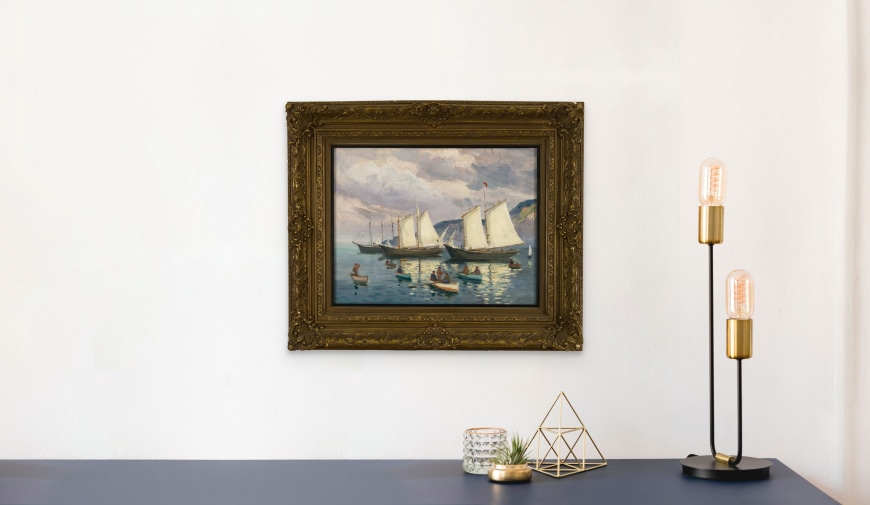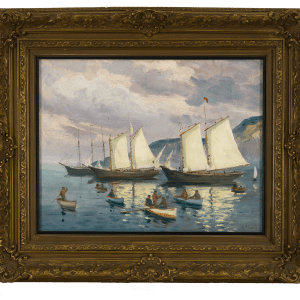-
Œuvres d'art
Robert PilotFishing Fleet at Anchor, Newfoundland1897-1967Oil on canvas14 x 18 inThis painting is presently on view at our Montreal gallery
35.6 x 45.7 cmSoldInscriptions
signed, ‘R. Pilot’ (lower right)Provenance
Private collection, Sillery, Quebec
Galerie Walter Klinkhoff Inc., Montreal, 1990
Private collection, QuebecSotheby's / Ritchies, Important Canadian Art, 28 May 2007, lot 9
Galerie Walter Klinkhoff Inc., Montreal
Property of a Distinguished Montreal Collector
In 1928, journalist Jean Chauvin met Pilot during a studio visit upon the artist’s return from a trip to the Maritimes, the day before a special exhibition. “We had the privilege to be some of the first to see all seventy paintings and sketches that the young painter made during his seven-week stay on the Atlantic coast,” recalled Chauvin. The artist visited the Maritime provinces several times, which makes it difficult to accurately date the paintings from these trips.
Pilot became interested in fishing boats when travelling to Brittany, and Concarneau in particular, in 1921 and 1922, painting several coastal locations in the Atlantic provinces when he returned. Starting with his hometown of St. John’s, but also Yarmouth, Peggy’s Cove and Lunenburg in Nova Scotia, as well as St. Andrews and Grand Manan in New Brunswick, to name a few.[1] As depicted in his work exhibited in the 1920s or sold since, Pilot toured fishing towns at a time that was seeing the end of cod drying and, consequently, the decline of traditional schooners. This was another world on the verge of extinction, similarly to his scenes and views of Quebec City.
Pilot used these scenes of Atlantic ports and fishing towns to create beautiful studies of light and atmosphere, especially of the contrasting rocky landscapes and the white sails of the boats. The Impressionist painter relished the coastal weather, with its sudden fogs, shimmering reflections on the sea, and ever-changing, sometimes menacing, skies. This is well illustrated in the two seascapes…
In St. John’s, Pilot puts schooners at the centre of his compositions, all sails out and anchored or gliding through the harbour, using diagonal lines. In the first painting, the fishing boats move toward the ships, energizing and enlivening the scene with their splashes of colour. In the second, the white sail stands out from the harbour and the turquoise masses of Signal Hill, crowned by the Cabot Tower—now a National Historic Site—as well as the nearby hill…
In Unloading the Schooner, the artist focuses on maritime activity on a wharf in an unidentified harbour—a place swarming with figures, busy unloading the vessel.
Mario Béland
Mario Béland holds a Ph.D. in art history from Université Laval and was curator of Art Ancien du Québec at the Musée national des beaux-arts du Québec from 1985 to 2014. He has curated, coordinated and collaborated on over 40 permanent or temporary exhibitions, some of which were accompanied by important catalogues and won prestigious excellence awards. His curatorial work includes monographs on sculptors Louis Jobin (1986) and Jean-Baptiste Côté (1996) and painters Antoine Plamondon (2005) and Napoléon Bourassa (2011). His thematic exhibitions include Painting in Quebec, 1820-1850 (1991–1992), Restauration en sculpture ancienne (1994), Les Génies de la mer (2001), and Québec et ses photographes, 1850-1908 (2008). Author of Marius Barbeau et l'art au Québec (1985) and a book on painter Eugène Hamel (2007), Béland has also published hundreds of articles, essays and notes in magazines, collective works and exhibition catalogues. A fellow of the Royal Society of Canada since 2009, Béland was the recipient of the Prix Carrière from the Société des musées du Québec in 2014, the Award of Distinguished Service from the Canadian Museums Association in 2016, and the Award of Excellence in the Professional category from the Conseil du patrimoine religieux du Québec in 2021.
_________________________________
Footnote:
[1] Various views of Grand Manan Island in the Bay of Fundy were exhibited at the AAM and the RCA between 1926 and 1932, two of which, dated 1926, can be found at the Beaverbrook Art Gallery in Fredericton and the Art Gallery of Ontario in Toronto.
1sur 2













